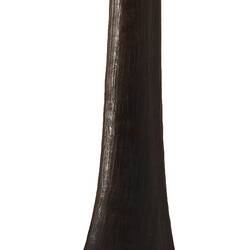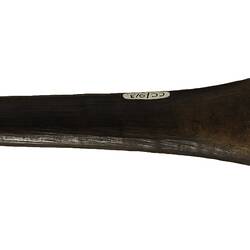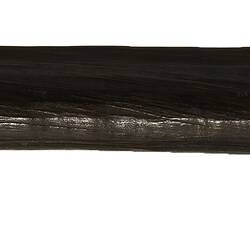Summary
The yamma is a unique wooden implement used mainly by the Barkindji and other groups in the Lachlan-Darling River area of western New South Wales. It is a dual-purpose digging tool that functions as both a shovel and digging stick. The pointed end of the yamma was used to open up termite mounds and honey ant nests, and to strip bark from the trees. The yamma was also used for collecting edible tubers and for unearthing small marsupials and reptiles from their burrows. The pointed end assisted in loosening the soil and the shovel was used to remove the soil to expose the animal or plant. Yamma were also used for digging out earth ovens and for removing cooked meat from a fire.
'King Billy', a Barkindji man, carved this yamma from hard, dense redwood with an axe, shaping the shovel end with an adze or chisel. He made and used the yamma, as well as two clubs, a shield and boomerang in 1860, before giving them to one of the first European settlers on the Darling River. It is important to note that the concept of 'King' was introduced and imposed on Aboriginal society by the white invaders as a way of conferring importance and status to Aboriginal men and women who distinguished themselves as useful allies to the colonising project. The people chosen by white authorities to hold this title, whilst sometimes being natural leaders in their communities, were not considered 'Kings' or 'Queens' in their own communities and did not hold autonomous rights to decision making, a concept foreign to Aboriginal culture. The names given along with the title of 'King' or 'Queen' were often generic European names that bore no relationship to the birth-name of the person.
Local Name
Yamma
Physical Description
The shovel has a fairly deep digging end that is crescentic in cross section. The handle tapers from the outside of the shovel to a pointed end. The handle is darkened with a stain while the shovel end remains quite light. The end of the handle is lightly incised with lines running lengthwise.
Significance
The Barkindji people are the recognised traditional owners of the area comprising the lower Darling River which they call the Barka, Barkindji literally meaning "people of the Barka".
In 2015, after an intensive 18-year fight, the Barkindji people won their native title claim which encompasses pockets of land spread across 128,000 square kilometres of Barkindji country, extending from the South Australian border to Tilpa in the east, Wentworth in the south and north, almost to Wanaaring. Within this huge area lie the rural centres of Broken Hill, Wilcannia and Menindee. Winning native title does not mean that the Barkindji peoples now own their land and it does not confer the right to sell or lease land as a property deed would. Native title must be seen instead as an acknowledgement of pre-existing Indigenous rights and interests - giving the Barkindji people the right to engage in such activities as camping, hunting and conducting burials on their land as their ancestors have done for thousands of generations. Native title also gives the Barkindji a place at the negotiating table when development projects are being discussed.
More Information
-
Object/Medium
Digging implement
-
Maker
-
Cultural Groups
-
Locality
-
Date Produced
-
Collector
-
Object Measurements
670 mm (Length), 110 mm (Width), 40 mm (Height)
-
Classification
-
Date Made
-
Maker
-
Clan/Language Group
-
Place Made
-
Indigenous Region
-
Keywords
-
Collection Names
-
Type of item
-
Discipline
-
Category
-
Collecting Areas



